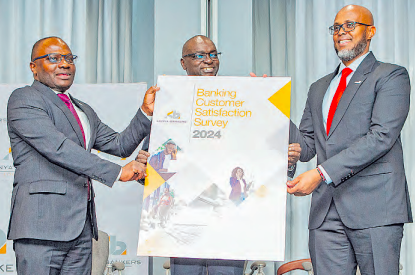
POOR service, fees and charges rank high among customer concerns in a new banking survey released on Wednesday.
The 2024 customer perception survey by the Kenya Bankers Association places those dissatisfied with their banking services at 47.3 percent followed by 46 percent whose concerned are fees and charges.
According to Chief Executive Officer of the KBA Raymond Molenje, together, these two factors show that service quality and pricing remain central to customer loyalty and retention.
“These findings stress the need for banks to prioritise excellent customer service, maintain competitive pricing, and invest in seamless digital banking solutions,” said Molenje.
Transparency issues also ranked high among customer concerns, with 31.9 per cent of respondents expressing dissatisfaction with the clarity of their banking relationships.
Additionally, service-related problems such as long wait times (30.1 per cent), security concerns (29 per cent), and poor issue resolution (32.7 per cent) further highlighted the need for banks to improve operational efficiency and build stronger customer trust.
Competition Authority of Kenya Director General David Kemei said that there are concerns regarding transparency in banking fees and charges. He pointed out that despite past market studies conducted by CAK in 2015 and 2018 that exposed hidden charges, customers continue to report dissatisfaction with non-disclosure of fees and high transaction costs.
“We still see issues of unclear fee structures and high service charges. Banks must adopt more transparent pricing models and ensure customers fully understand the costs associated with financial services,” he said.
Despite the complaints, customer loyalty to their banks also grew to 58.1 per cent in 2024 from 54.8 per cent in 2023.
However, even with the increased push for customer satisfaction, more than half of the (56.49 per cent) of customers prefer self-service channels, such as mobile apps and internet banking, reflecting a growing demand for convenience and 24/7 access.
The shift toward digital banking continued to gain momentum in 2024, with mobile and online banking maintaining their dominance as the preferred banking channels.
According to the survey, both mobile banking (via USSD and apps) and internet banking secured the highest scores, continuing trends seen in 2023.
Last year, mobile banking led with a 69.9 percent preference, followed by internet banking at 24.6 per cent.Despite the digital surge, KBA maintains that bank branches remain a key touchpoint, ranking third in 2024.
“Bank branches continue to be important, ranked third in 2024, reflecting sustained demand for in-person services, similar to 2023 where branches were also highly preferred but showed a slight decline,” the survey says.
A notable shift in 2024 is the diminishing role of ATMs. While they held the fourth spot in 2023 with a 17.7 per cent preference, their importance has slightly waned, scoring lower in this year’s survey.
Meanwhile, card payments (including online and point-of-sale transactions) and cash deposit machines continue to see moderate usage, both ranking at 3 in 2024.
These channels showed similar engagement levels in 2023, where card payments stood at 7.1per cent and cash deposit machines at 2.77per cent, reflecting their ongoing but relatively lower adoption compared to mobile and online banking.
At the bottom of the ranking, contact centres saw the lowest preference in 2024, reinforcing the continued decline of call-based banking support.
This mirrors 2023 trends, highlighting a growing consumer preference for self-service and digital-first banking solutions over phone-based assistance.
“As digital banking solidifies its dominance, financial institutions may need to adapt their strategies, balancing technological advancements with the enduring need for physical touchpoints,” the survey says.

